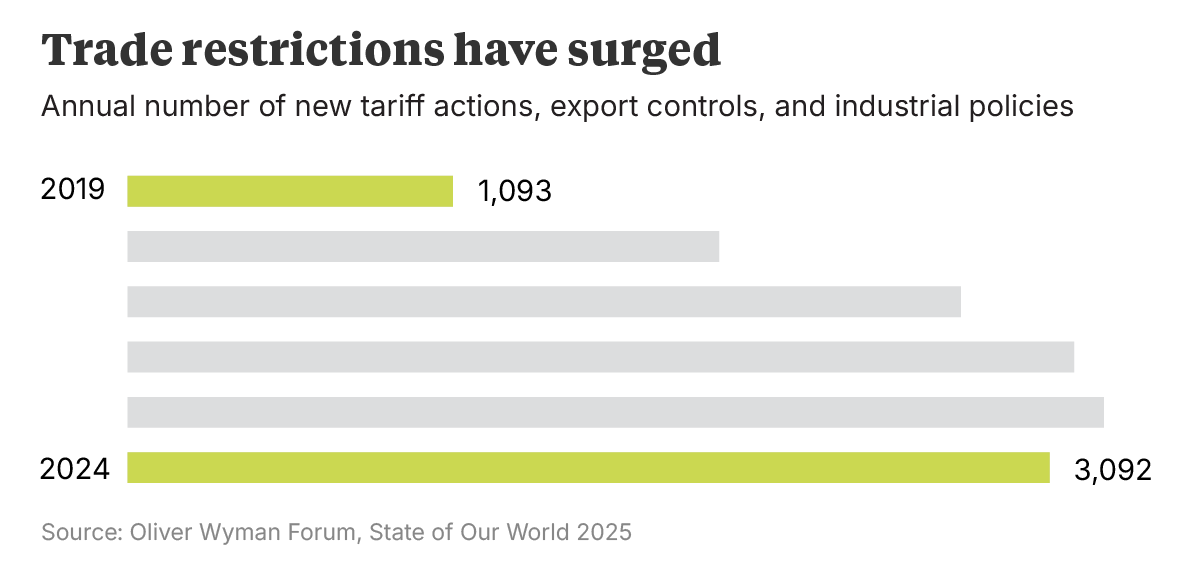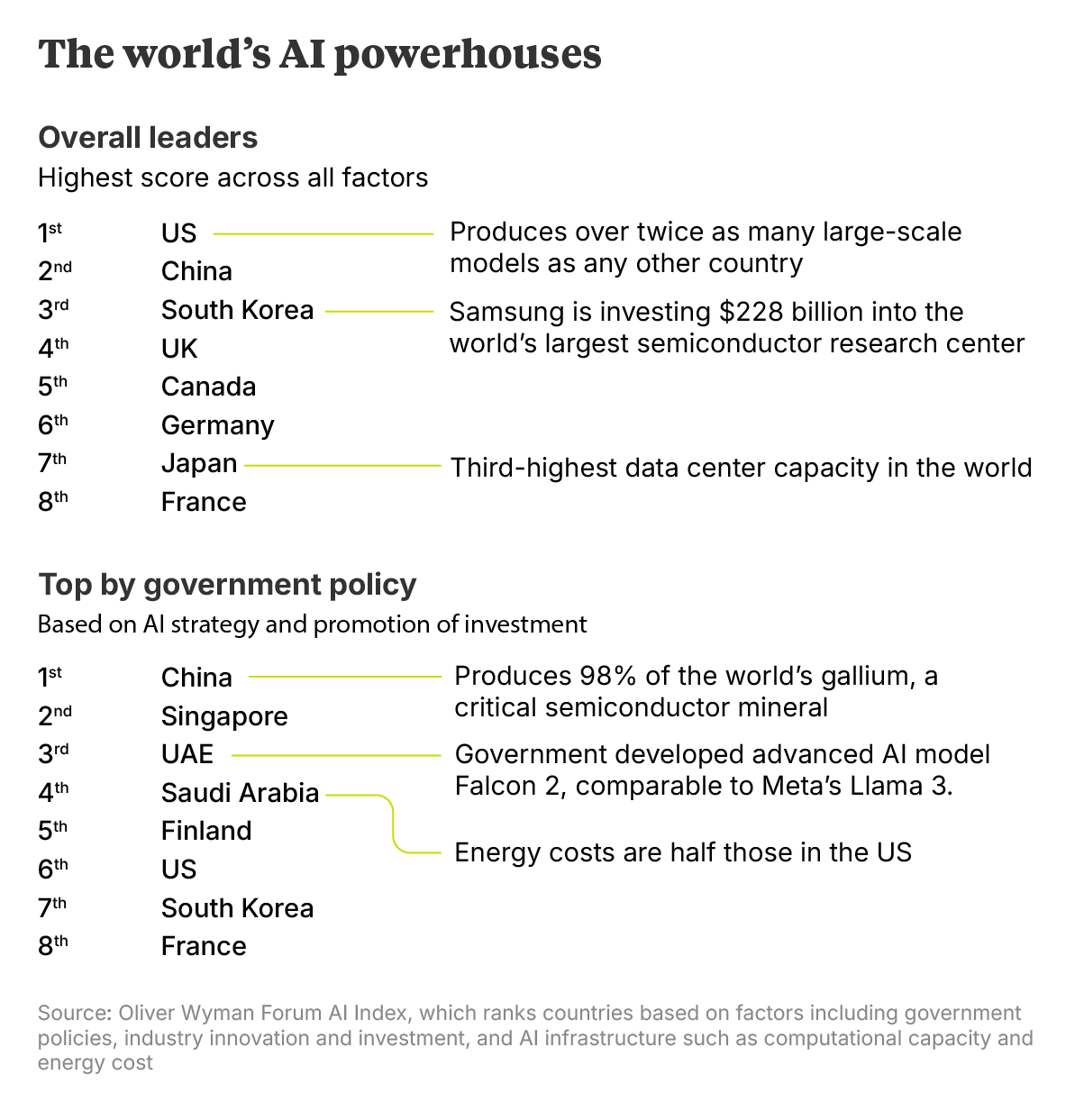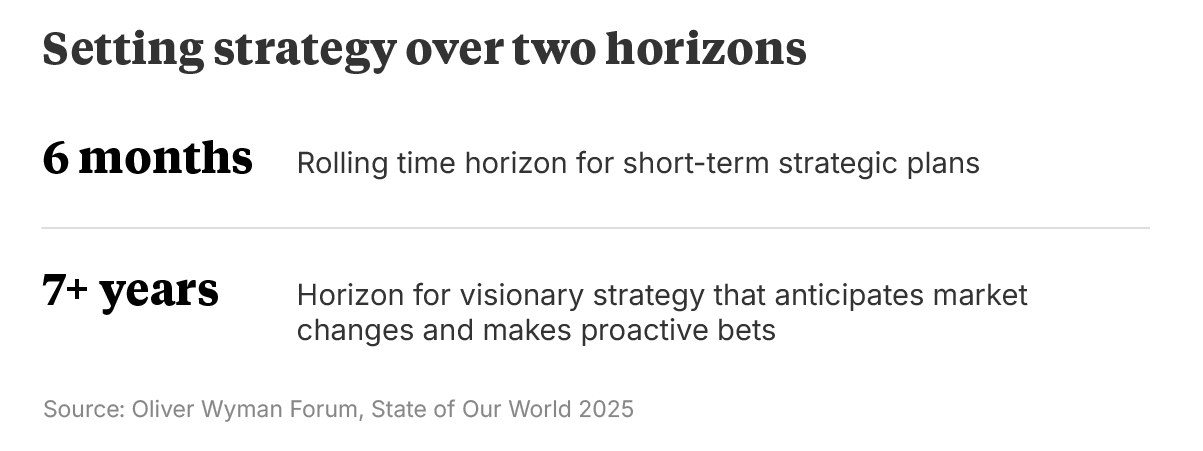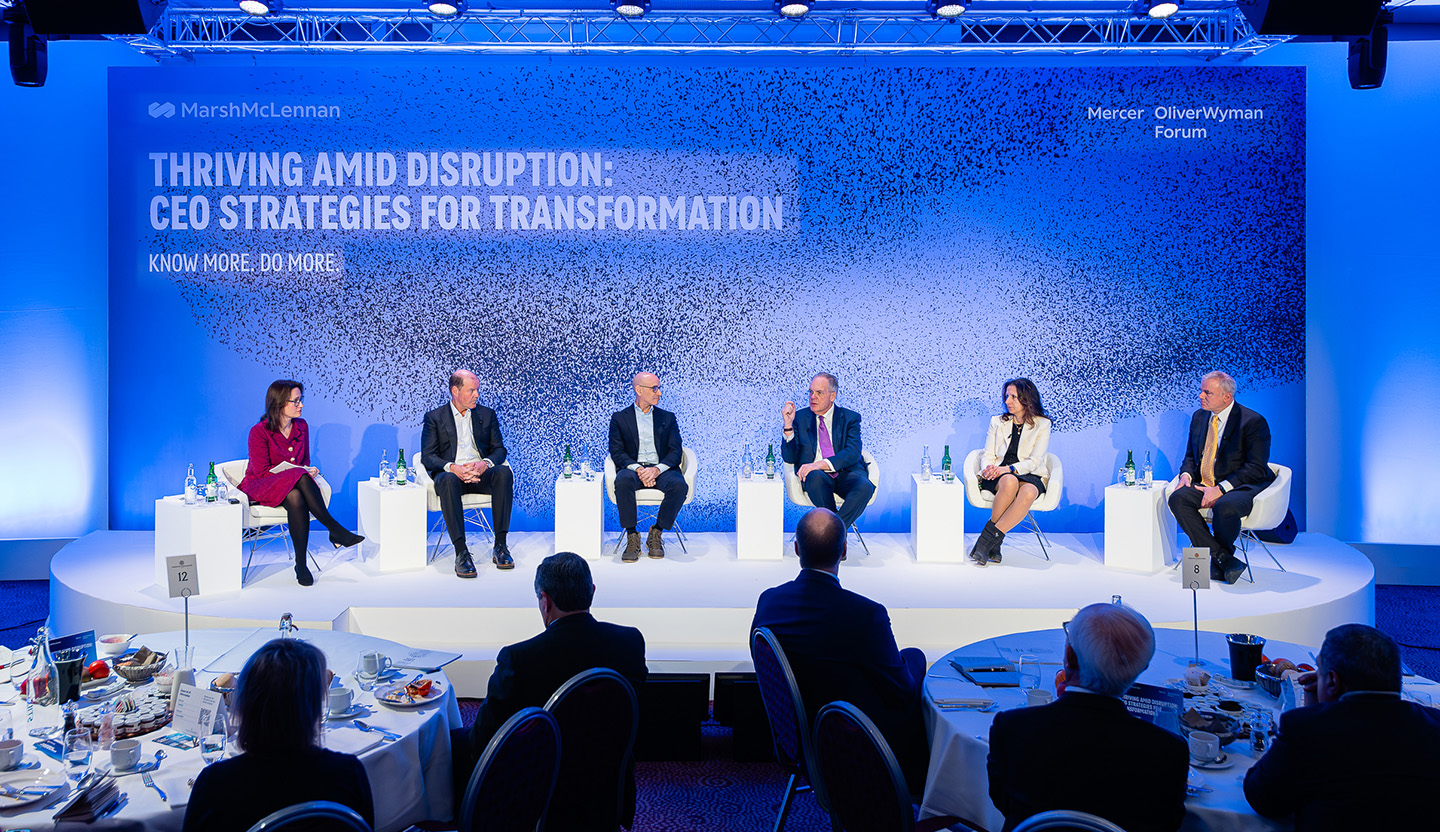Accelerating disruption is the defining feature of our times, yet we struggle to deal with the scale and pace of change that’s occurring. Consider the race to dominate artificial intelligence (AI). It pumped up the so-called magnificent seven US tech stocks to account for a third of the S&P 500 by market value in January, up from 20% when ChatGPT was released two years ago, only to have news of a less expensive, open-source model from China's DeepSeek knock more than a trillion dollars off the value of US tech stocks in a single day.
This environment of transformative change across multiple dimensions — from rising geopolitical tensions and economic nationalism to technological acceleration amid aging if not shrinking labor forces — requires businesses and governments to shift their mindset. Leaders need to accelerate their decision-making to anticipate challenges and turn disruption into opportunity.
State Of Our World 2025, a new report presented by the Oliver Wyman Forum at the World Economic Forum Annual Meeting in Davos, identifies nine of the most important global trends impacting business and society today, and how leaders should respond to them. They range from the ascendance of geopolitical factors like tariffs and restrictions on AI chip exports to striking the right balance on regulation for promoting sustainable growth; from unlocking the value of AI to embracing a new approach of meeting customer needs; and from the importance of a truth-based culture in today’s post-fact world to reinventing the CEO role for an era of ever faster disruption.
Many of these trends overlap with and reinforce each other. Reaping the benefits of AI, for instance, will require more-agile workforce strategies focused on rapidly evolving skills rather than experience and hierarchy, while those benefits in turn can help companies and societies deal with worker shortages as populations decline in more parts of the world.
Adopting a geopolitics-first mindset
The influence of politics on markets looks more and more like an enduring feature of our world, and a stark contrast to the free-trade ethos that reigned during the peak globalization years at the start of this century. Tariffs, export controls, and industrial policies have tripled in the past five years, and the United States, China, and the European Union have accounted for 55% of all commerce-distorting interventions since 2009.

The tectonic plates of the geopolitical world have shifted. Economic power is more widely dispersed than ever today between the United States and its friends and allies, challengers led by China and Russia, and multi-aligned countries such as India, Indonesia, and Brazil. But the world’s AI and defense capabilities are concentrated in a small set of countries and companies. In this environment, CEOs need to make geopolitics a first consideration rather than an afterthought, and anticipate and shape public-private cooperation in a world where foreign policy is likely to become more transactional.
Unlocking AI’s Value
Consumers and companies have adopted generative AI much faster than other recent tech innovations like the internet or cell phones, but the payoff is proving slow to materialize. While 97% of organizations have used AI as a strategic lever for transformation, only 17% say their investments have exceeded expectations, according to an Oliver Wyman survey of 300 global firms.

To drive real success, companies need a strategy to capitalize on the geopolitical, industrial, and organizational dimensions of AI. In the first category, the Oliver Wyman Forum AI Index identifies eight countries as AI leaders by factors including their startup culture and funding, semiconductor and data center capabilities, energy capacity and cost, and government policy. Companies will need to navigate emerging blocs of influence in a world where great power competition makes it harder to play all sides.
Businesses should look at early industry experience to decide what value they want to prioritize — efficiency gains or revenue growth. They also need to set a clear transformational strategy. That could be going all in on pursuing enterprise-wide transformation or pursuing more-targeted use cases at a measured pace. The choice should reflect the organization’s capabilities and resources, regulatory environment, and competitive dynamic.
A new CEO model for capitalizing on disruption
Today’s business leaders face a conundrum. They need to make transformative plays to drive growth amid dramatic changes in technology, markets, and politics, yet shorter CEO tenures mean many of them won’t last in the job long enough to see the fruits of their efforts.

That dilemma requires a two-pronged leadership approach. CEOs should pursue efficiency initiatives and routine investments through rolling six-month plans tracked against real-time market signals that allow for course corrections. And for real transformation, leaders should adopt visionary seven-year or longer plans with strategic bets based on their view about trends in technology, competition, regulation, and changing consumer preferences.
Such growth strategies should be rooted in a genuine culture of truth-seeking. That may sound quixotic in a world awash in subjective “truths,” but long-term success requires that organizations invest in mission-critical data, challenge assumptions, ensure that meetings surface any uncomfortable facts, actively identify vulnerabilities, and be ready to rapidly counter disinformation.
By Ana Kreacic and John Romeo
There was a heady mix of promise and uncertainty in the air at Davos last week but little in the way of consensus.
The uncertainty reflects the new geopolitical order in which politics shape markets more than markets shape politics. Superpower competition is back, state and non-state actors are rearming, industrial policy is replacing competition, and economic tools are being weaponized. It was notable that most executives at the World Economic Forum’s latest Annual Meeting accepted tariffs as part of the policy mix even as they seek to shape or minimize the impact on their businesses.
The promise comes from technology. For the first time in history, we can augment the human body and mind. This carries enormous potential, and it was great to see the debate around artificial intelligence (AI) shifting away from a simple calculation of efficiency to the potential for growth, new business models, and responsible continued development.
But where you stand today really does depend on where you sit. US participants were brimming with confidence even as they remained uncertain about the potential impact of the Trump administration’s policies. European executives and policymakers worried about the weakness of their economies and their ability to innovate – many reflecting on a need to reset regulation. Emerging economic powers from the Gulf states to India, Indonesia, Brazil, and beyond were eager to latch onto American optimism while China’s presence was uncharacteristically modest and subdued.
CEOs operate at the nexus of all these forces and have to understand and interpret the external world and connect it with how they run their companies. And if there was any consensus at Davos, it was a sense of urgency, a need to have more conversations, and take consequential business decisions at a pace that would have seemed reckless a few years ago because the world is moving at warp speed.
Take AI, for example. Agentic AI was the buzz of Davos, with Salesforce CEO Marc Benioff and Axios journalist Ina Fried taking “shots” (of water) every time one of them said the word “agent” during their panel discussion. Humor aside, the discussions were grounded in real experience and lessons learned, including the need to help employees acquire the skills to capture the benefits of the technology.
At the same time, participants were left to ponder two radically different visions for AI’s future: A plan to invest up to $500 billion in US AI infrastructure involving OpenAI, SoftBank, Oracle, and the United Arab Emirates’ fund MGX, and R-1, an open-source reasoning model that China’s DeepSeek says matches OpenAI’s o1 in performance at a fraction of the cost.
Another theme, which was expressed mainly in side conversations but likely will demand greater attention going forward, is the need for trust. The scariest statistic from our Global Consumer Sentiment Survey is that only 15% of employees express very high confidence in their CEOs’ ability to drive growth. The latest Edelman Trust Barometer, meanwhile, finds a growing sense that government and business serve narrow interests rather than regular people. Four in 10 respondents across 28 countries approve of one or more forms of hostile activism – ranging from attacking people online and spreading disinformation to threatening or committing violence – to bring about change.
The good news is that, compared with a decade ago, today’s leaders have been tested in resilience in a way we haven’t seen in a long time. That is a tremendous muscle for CEOs to call on in an uncertain world.
Ana Kreacic is COO and John Romeo is CEO of the Oliver Wyman Forum

Ana Kreacic (left), COO of the Oliver Wyman Forum, moderates a Davos CEO panel on corporate transformation with (moving to the right) Takeda’s Christophe Weber, Pearson’s Omar Abbosh, State Street’s Ronald P. O’Hanley, NYSE Group’s Lynn Martin, and Mercer’s Pat Tomlinson.
What would you call a business that uses less than two-thirds of one of its key assets? Short-sighted, to say the least.
Women around the world enjoy less than two-thirds of the legal rights available to men, on average, limiting their ability to work, earn equal pay for work of equal value, or start a business, according to the World Bank’s latest Women, Business and the Law (WBL) report. That’s a tragic waste of potential at a time when we need to tap all our resources to revive a sluggish global economy, especially with the growth rate of the global labor force projected to fall by half over the next 25 years as the birth rate plummets and population ages.
Closing the gap in employment rates between men (currently 73%) and women (49%) over the next decade could double the global growth rate and raise the world’s GDP by more than 20%, according to WBL. So how do we make progress toward gender equality and lift everyone in society?
Female representation matters
Political power has a vital role to play. Women are more likely to enter the workforce if they have legal protections against discrimination, flexible work schedules, subsidized childcare, and other supportive measures. Such policies are more prevalent in countries where women hold more seats in legislatures and executive cabinet positions, according to a new report by the Oliver Wyman Forum, Women Political Leaders (WPL), and WBL, which was presented at the World Economic Forum Annual Meeting in Davos.
Yet progress toward gender equality has slowed recently after decades of gains.
Women made minimal progress last year in elections covering half the global population, with countries’ average share of women in lower and single houses of parliament increasing by just three-tenths of a percentage point, to 26.1%.
An agenda for change
What’s needed is a fresh approach that pushes for reform across a wide range of power centers, including the private sector. Advocates should make clear that gender equality is not a zero-sum game because it can drive stronger economic growth and widespread prosperity.
Governments should support policies that tackle gender inequality and address issues that make it difficult for women to enter and remain in the workforce. Enacting laws that expand the availability of childcare, for example, could increase women’s labor force participation by 2% on average, according to World Bank research. Governments also can ensure that existing equal opportunity laws are enforced and have adequate supporting frameworks. While 98 economies tracked by WBL mandate equal pay for work of equal value, only 35 have pay-transparency or enforcement measures that can make equal pay a reality.
The private sector, meanwhile, can provide on-site or subsidized childcare and offer flexible hours, remote working arrangements, and paid family leave. They also can implement robust policies against discrimination and harassment, adopt and enforce equal pay standards, and establish mentorship and sponsorship programs to develop a strong pipeline of female leaders.
At the current rate of change, it would take at least 50 years on average for countries to achieve legal gender equality, WBL has estimated. That’s too long to wait.
|
|
|---|

